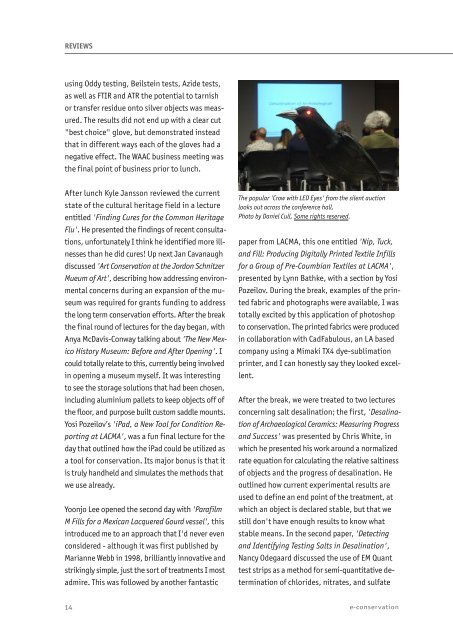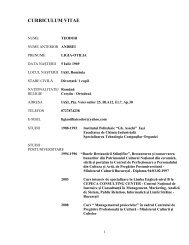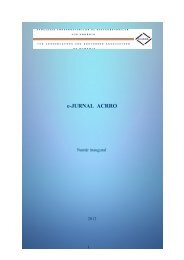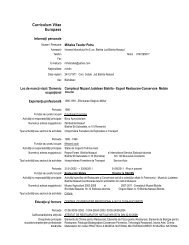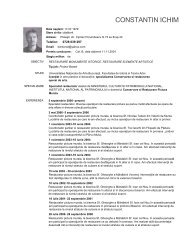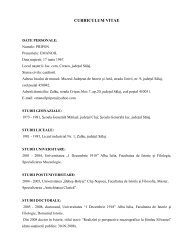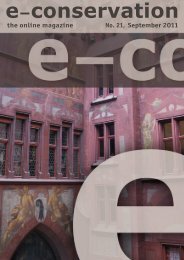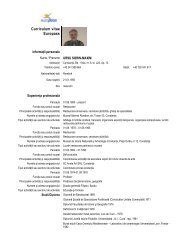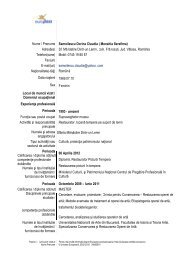e-conservation the online Magazine 16, oct 2010.pdf
e-conservation the online Magazine 16, oct 2010.pdf
e-conservation the online Magazine 16, oct 2010.pdf
Create successful ePaper yourself
Turn your PDF publications into a flip-book with our unique Google optimized e-Paper software.
REVIEWS<br />
using Oddy testing, Beilstein tests, Azide tests,<br />
as well as FTIR and ATR <strong>the</strong> potential to tarnish<br />
or transfer residue onto silver objects was measured.<br />
The results did not end up with a clear cut<br />
"best choice" glove, but demonstrated instead<br />
that in different ways each of <strong>the</strong> gloves had a<br />
negative effect. The WAAC business meeting was<br />
<strong>the</strong> final point of business prior to lunch.<br />
After lunch Kyle Jansson reviewed <strong>the</strong> current<br />
state of <strong>the</strong> cultural heritage field in a lecture<br />
entitled 'Finding Cures for <strong>the</strong> Common Heritage<br />
Flu'. He presented <strong>the</strong> findings of recent consultations,<br />
unfortunately I think he identified more illnesses<br />
than he did cures! Up next Jan Cavanaugh<br />
discussed 'Art Conservation at <strong>the</strong> Jordon Schnitzer<br />
Mueum of Art', describing how addressing environmental<br />
concerns during an expansion of <strong>the</strong> museum<br />
was required for grants funding to address<br />
<strong>the</strong> long term <strong>conservation</strong> efforts. After <strong>the</strong> break<br />
<strong>the</strong> final round of lectures for <strong>the</strong> day began, with<br />
Anya McDavis-Conway talking about 'The New Mexico<br />
History Museum: Before and After Opening'. I<br />
could totally relate to this, currently being involved<br />
in opening a museum myself. It was interesting<br />
to see <strong>the</strong> storage solutions that had been chosen,<br />
including aluminium pallets to keep objects off of<br />
<strong>the</strong> floor, and purpose built custom saddle mounts.<br />
Yosi Pozeilov’s 'iPad, a New Tool for Condition Reporting<br />
at LACMA', was a fun final lecture for <strong>the</strong><br />
day that outlined how <strong>the</strong> iPad could be utilized as<br />
a tool for <strong>conservation</strong>. Its major bonus is that it<br />
is truly handheld and simulates <strong>the</strong> methods that<br />
we use already.<br />
Yoonjo Lee opened <strong>the</strong> second day with 'Parafilm<br />
M Fills for a Mexican Lacquered Gourd vessel', this<br />
introduced me to an approach that I'd never even<br />
considered - although it was first published by<br />
Marianne Webb in 1998, brilliantly innovative and<br />
strikingly simple, just <strong>the</strong> sort of treatments I most<br />
admire. This was followed by ano<strong>the</strong>r fantastic<br />
The popular 'Crow with LED Eyes' from <strong>the</strong> silent auction<br />
looks out across <strong>the</strong> conference hall.<br />
Photo by Daniel Cull, Some rights reserved.<br />
paper from LACMA, this one entitled 'Nip, Tuck,<br />
and Fill: Producing Digitally Printed Textile Infills<br />
for a Group of Pre-Coumbian Textiles at LACMA',<br />
presented by Lynn Bathke, with a section by Yosi<br />
Pozeilov. During <strong>the</strong> break, examples of <strong>the</strong> printed<br />
fabric and photographs were available, I was<br />
totally excited by this application of photoshop<br />
to <strong>conservation</strong>. The printed fabrics were produced<br />
in collaboration with CadFabulous, an LA based<br />
company using a Mimaki TX4 dye-sublimation<br />
printer, and I can honestly say <strong>the</strong>y looked excellent.<br />
After <strong>the</strong> break, we were treated to two lectures<br />
concerning salt desalination; <strong>the</strong> first, 'Desalination<br />
of Archaeological Ceramics: Measuring Progress<br />
and Success' was presented by Chris White, in<br />
which he presented his work around a normalized<br />
rate equation for calculating <strong>the</strong> relative saltiness<br />
of objects and <strong>the</strong> progress of desalination. He<br />
outlined how current experimental results are<br />
used to define an end point of <strong>the</strong> treatment, at<br />
which an object is declared stable, but that we<br />
still don't have enough results to know what<br />
stable means. In <strong>the</strong> second paper, 'Detecting<br />
and Identifying Testing Salts in Desalination',<br />
Nancy Odegaard discussed <strong>the</strong> use of EM Quant<br />
test strips as a method for semi-quantitative determination<br />
of chlorides, nitrates, and sulfate<br />
14 e-<strong>conservation</strong>


